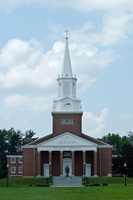 | Back to e-WV
| Back to e-WV
 The West Virginia Encyclopedia
The West Virginia Encyclopedia
 | Back to e-WV
| Back to e-WV
 The West Virginia Encyclopedia
The West Virginia Encyclopedia

Located in Buckhannon, West Virginia Wesleyan College initially opened as the West Virginia Conference Seminary on September 3, 1890. Its founding climaxed decades of effort by the Methodist Episcopal Church to establish an educational institution within the state. In that first year, 201 men and women undertook a largely preparatory school curriculum. Gradually the school added college-level studies and awarded its first five degrees in 1905. After one year as Wesleyan University of West Virginia, the college adopted its present name in 1906, becoming one of at least 20 American institutions of higher education to be named for the founder of Methodism, John Wesley.
When the three major bodies of Methodism reunited in 1939, healing a regional split dating back to the Civil War era, the West Virginia Annual Conference decided to discontinue ties with the Southern church’s college, Morris Harvey (now University of Charleston), and concentrate on building Wesleyan as a strong liberal arts college. In keeping with its historic mission, West Virginia Wesleyan still continues close affiliation with the United Methodist Church, which elects its board of trustees. The campus hosts annual meetings of the Methodist Conference and is the repository of its Commission on Archives and History.
From the first president, Bennett W. Hutchinson, until 1973, leadership was drawn from among Methodist ministers. Of the 17 presidents, Roy McCuskey (1931– 41) is particularly remembered for sustaining Wesleyan through the difficult years of the Depression. Wartime brought further strain when enrollment dropped below 200, the waning numbers augmented by military training units on campus. Through these crises trustee support was guided by long-term board chairman Clyde O. Law (1933–56). As the college grew after World War II, President Stanley H. Martin (1957–72) directed a major expansion of facilities and faculty to serve an enrollment tripling that of previous years. Jay Rockefeller, later governor and U.S. senator and not a clergyman, became president of West Virginia Wesleyan in 1973. President William R. Haden assumed leadership in 1995 and announced retirement plans in 2005. He was succeeded as president by Pamela Balch, a 1971 Wesleyan graduate who became the first woman to head the college. She left in December 2016. Dr. Joel Thierstein served as president from 2016 to 2022. Dr. James Moore served as interim president from February 2022 until becoming the official president in September 2023.
While its primary curriculum is that of a traditional college of liberal arts and sciences, Wesleyan has from its beginning also sought to prepare graduates in selected applied fields and is accredited by national agencies for teacher education, nursing, business, allied health, and music. Since 1986, a master’s degree in business administration has been offered, primarily enrolling employed professionals, as did previous graduate courses in teacher education. A full information technology program throughout the campus provides resident students access to digital resources around the world, and distance learning courses serve those off campus.
In recent decades undergraduate enrollment hovered around 1,500. By fall 2021, it had dropped to 1,054 and to 951 by fall 2022. West Virginians constitute about 45 percent of the graduating classes. A few international students graduated as early as 1922, but the establishment of the Dorothy Lee Scholarship in the 1940s and recent exchange arrangements have brought students from about 20 countries to Wesleyan. Foreign students make up nearly five percent of the enrollment.
The campus occupies approximately 80 acres within the city of Buckhannon. Agnes Howard Hall, built as a residence for women in 1895 and now on the National Register of Historic Places, stands alongside the slightly younger Lynch-Raine Administration Building and Annex to compose the historic heart of the campus. Campus construction since the mid-20th century has followed a unifying Georgian architectural style.
The campus centerpiece, Wesley Chapel, opened in 1966 and seats 1,800, the largest church sanctuary in the state. Inside are wooden statues of the 12 apostles, handcarved by West Virginia artist Wolfgang Flor, and the magnificent 4,244-pipe Rohrbough Memorial Organ, connected to the 183 Shannon bells which chime the hours and play twice a day. Two features dominate the chapel’s exterior: the soaring bell tower and steeple, a Buckhannon landmark, and a bronze statue of John Wesley overlooking the central campus.
Several buildings carry the names of benefactors of the college: the Benedum family and Claude Worthington Benedum Foundation; Edna Jenkins; the L. L. Loar family; Annie Merner Pfeiffer; and the Frank Christopher family. The first endowed professorship was established by an alumnus, Arthur Workman.
Primarily a residential college, Wesleyan offers a rich campus life program, including opportunities in choral and instrumental music, theater, and visual arts. Structured intramural and outdoor recreation activities complement the 17 varsity teams that compete in the West Virginia Intercollegiate Athletic Conference. Beginning in 1925, the Greek fraternal system replaced earlier literary societies; 11 national social organizations now have local chapters at Wesleyan. National academic and leadership societies on campus include Phi Kappa Phi, Mortar Board, Omicron Delta Kappa, and various departmental honoraries.
Wesley Chapel provides the center for an ecumenical chapel and religious life program. A long-standing student tradition of service to the community, once expressed by deputation teams working in area churches, persists in the current activities of the Community Service Center, service fraternities, and the Bonner scholarship program.
West Virginia Wesleyan College website
Written by Kenneth B. Welliver
Plummer, Kenneth M. A History of West Virginia Wesleyan College 1890-1965. Buckhannon: West Virginia Wesleyan College Press, 1965.